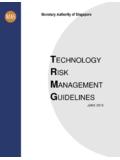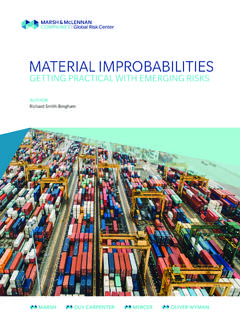Transcription of FINANCIAL RISK MANAGEMENT IN EMERGING MARKETS …
1 FINANCIAL RISK MANAGEMENT IN EMERGING MARKETSFINAL REPORTE merging MARKETS Committeeof theInternational Organization of Securities CommissionsNovember 1997 SUMMARYTOPICPAGE1. INTRODUCTION32. TYPES OF RISK3 Evolution of risk management4A word about Value-at-Risk5 Topics of the current agenda7 The role of regulators in risk management83. THE PRESENT STUDY10 Scope10 Goals 11 Methodology114. SUMMARY OF FINDINGS COLLATED FROM THEQUESTIONNAIRE11 Introduction11 Summary of findings12 Existence of organized futures and options exchanges12 Existence of OTC MARKETS for derivatives12 Regulatory Structure13 Aggregated cross- market surveillance13 Capital requirements13 Internal controls and prudential policies14 Position Limits14 Foreigners participation in derivatives markets15 Public Disclosure15 International cooperation agreements15 Training programs15 Major problems related to risk MANAGEMENT procedures155.
2 CONCLUSION166. GENERAL GUIDELINES FOR RISK MANAGEMENT BESTPRACTICES IN EMERGING MARKETS177. TOPICS FOR FURTHER RESEARCH18 REFERENCES20 ANNEX COMPILATION OF ANSWERS TO THE QUESTIONNAIRE2231. INTRODUCTIONThe growth in volume and complexity of FINANCIAL MARKETS , speciallyderivatives MARKETS , over the past few years, together with a handful of notoriousfinancial disasters arising from ill-conceived derivatives transactions, in the contextof worldwide integration of FINANCIAL MARKETS , have increased concern over the riskintroduced by derivatives and other complex instruments into the global individual firms level, this poses an increasing threat to their ability tokeep control over their exposure to risk in a diverse environment. At an aggregatelevel, there has been some fears that default by one firm could spread out to others inthe same country or even cross-borders, and become a FINANCIAL crisis of hugeproportions.
3 This is a major concern not only for regulators, but also for marketsparticipants this context, risk MANAGEMENT has become an essential part of firms andregulators activities. A risk MANAGEMENT system is a valuable instrument for assessingthe exposure to risk that participants in the FINANCIAL sector in general are subject such systems, managers can measure risk across MARKETS in terms of theirpotential impact on profit and loss, quantify capital allocation to MARKETS and dealers,establish meaningful risk limits and supervise systems also provide a measure of the amount of capital necessary toprovide a cushion against potential future losses, a vital element for both managersand regulators. The FINANCIAL marketplace strenght, as a whole, ultimately dependsupon individual firms ability to cover unexpected losses with capital reserves. Evenfirms using the best risk MANAGEMENT systems are statistically subject to losses, andthen a proper capital cushion is essential.
4 Not surprisingly, setting capital adequacystandards is at the core of regulators responsibilities, together with efficientsurveillance and supervision of market , aiming at the development of standards of best practices related toregulatory matters, has been examining and assessing its members current stage,actions and policies concerning risk MANAGEMENT in FINANCIAL MARKETS . Several reportshave been published, some of them together with the Basle Committee, focusing onbanks and securities houses (see References). As part of this effort, the scope ofdiscussion of the current stage of risk MANAGEMENT has been extended to the membersof the EMERGING MARKETS TYPES OF RISKThe analysis of the FINANCIAL soundness of borrowers has been at the core ofbanking activity since its inception. This analysis refers to what nowadays is known ascredit risk, that is, the risk that a counterparty fails to perform an obligation owed toits creditor.
5 It is still a major concern for banks, but the scope of credit risk has been4immensely enlarged with the growth of derivatives MARKETS . Another definitionconsiders credit risk as the cost of replacing a cash flow when the counterpart far as derivatives are concerned, credit risk is much smaller in transactionsconsummated in organized exchanges, because of the intermediation of clearinghouses, their guarantees represented by margins and daily marking-to- market and thestrict monitoring of clearing members exposures .The extraordinary development and globalization of the FINANCIAL MARKETS ,specially derivatives MARKETS , has brought about another kind of risk almost unheardof not many years ago: market risk, or the risk that adverse movements in assetsprices will result in loss for the firm. Here the definition encompasses not onlyfinancial and securities firms, but all kinds of firms, even Governmental bodies, whichmight be engaged in derivatives an aggregate level, the risk that a default by one individual firm triggers awave of failures across the market is known as systemic risk.
6 Depending on thespecific circumstances of an individual failure, and on market factors during thatperiod, systemic risk could become a real threat to vast portions of the financialsystem. The more MARKETS interweave across segments and borders, the bigger thesystemic risk result of the growing complexity of FINANCIAL MARKETS and instrumentsis the increasing importance of operational risk, that is, the risk of loss due to humanerror or deficiencies in firms systems and/or controls. In the same way, more complexarrangements and contracts bring about legal risk, or the risk that a firm suffers a lossas a result of contracts being unenforceable or inadequately documented. Finally,liquidity risk is the risk that a lack of counterparts leaves a firm unable to liquidate oroffset a position, or unable to do so at or near the previous market of risk managementRisk MANAGEMENT evolved from a strictly banking activity, related to thequality of loans, to a very complex set of procedures and instruments in the modernfinancial environment.
7 The first remarkable step to build a framework for systematicrisk analysis was the Basle Capital Accord, issued in July 1988. The aim of the Basleinitiative was to reach international convergence of rules governing the calculation oflevels of capital reserves for banks. The Accord set out the details and the agreedframework for measuring capital adequacy and minimum standards to be achieved bybanks within the jurisdiction of the national supervisory authorities represented on theCommittee, intended to be implemented in their respective Basle framework, in its original version, is mainly directed towardsassessing capital in relation to credit risk. The model sets out capital requirementsaccording to a formula based on risk factors applied to categories of assets, ratedaccording to their potential risk. The Basle directives are standardized, and have beenimplemented not only in the ten countries that were original members of the Banking5 Supervision Committee of the Bank for International Settlements, but also in manyother countries throughout the 1993, the Basle methodology was revised, and credit risk analysis wasimproved.
8 But, more importantly, new provisions, to take into account of market risk,already recognized as a major source of risk, were announced as a necessarydevelopment. A new methodology was put forward for discussion, contemplating astandard model for the assessment of market , by that time many leading banks and securities houses had alreadydeveloped their own proprietary models for the assessment of market risk. Thesemodels were based on the Value-at-Risk methodology, or VaR, and provided levels ofcapital reserves lower than those produced by the Basle Committee's proposedmethodology. This is so because VaR uses a portfolio approach, measuring risk in acomprehensive and integrated manner, taking into account the correlations betweenthe behaviour of prices of different assets that exist in diversified portfolios. Thestandard Basle methodology, on the other hand, uses a partial analysis, measuring riskas the summation of risks of individual assets, ignoring correlations and thus theeffects of diversification, thereby tending to overestimate total risk.
9 Firms argued thatthe VaR models were more accurate in capturing the overall exposure of large anddiversified portfolios than the standard Basle methodology, and consequently theirlower levels of capital reserves did not mean less , in January 1996, the Basle Committee on Banking Supervisionreleased an amendment to the July 1988 Capital Accord to apply capital charges to themarket risks incurred by banks. Another important innovation of the amendment wasthat it permits banks to calculate their market risk capital charges according to one oftwo models, the standardized measurement method or proprietary models based onVaR. Banks using internal models will be subject to a set of qualitative andquantitative standards, the outcome of their VaR calculations will have to bemultipled by three ( , take the model outcome and multiply it by 3 to set the level ofregulatory capital required) and their models are subject to approval by nationalregulators.
10 The amendment will come into effect by the end of , market risk MANAGEMENT is a major concern not only for banks,which are usually subject to stricter regulations in terms of capital adequacy, but alsofor securities firms and broker-dealers. Also clearinghouses have developed modelsfor the calculation of margins in derivatives MARKETS and monitoring of risks incurredby their word about Value-at-RiskVaR can be defined as the maximum loss on a portfolio, over a standardizedperiod of time, usually one day, that would result from an adverse market movementexpected to occur once in a longer period of time, usually one hundred days, within aconfidence interval, usually 99%. Alternatively, it can be seen as the estimated changefrom the present price of an instrument (or portfolio) until the point at which it could6be liquidated. The VaR methodology views a firm as a giant portfolio, and produces asingle currency-denominated figure indicating the risk across many financialinstruments and MARKETS on a firm-wide level, avoiding the overestimation problemcaused by partial analysis.





